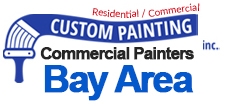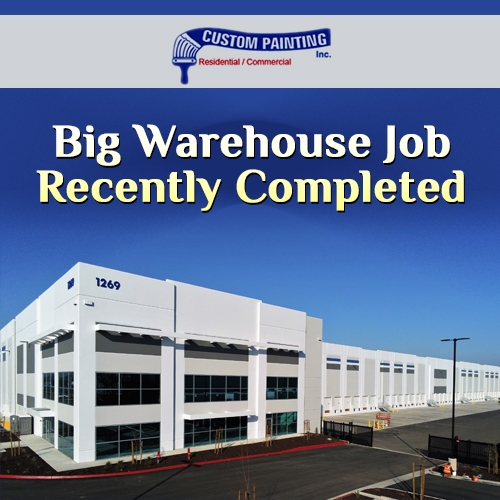Founded in 1982, Custom Painting, Inc. is a full-service painting company serving residential and commercial clients in the San Francisco Bay Area. We offer a wide range of interior and exterior commercial painting services, including power washing, complete surface preparation work, priming, cabinet painting, staining application, and more.
As the name implies, Custom Painting, Inc. does custom work to meet the expectations and preferences of our clients, whether it’s painting different colors or doing installations, such as crown molding or wainscoting.
Custom Painting, Inc. recently completed a project at a large warehouse in Tracy, CA. The warehouse, called IPT-4 Grantline, measures around 600,000 square feet. Our paint crew had to cover the interior and exterior of the building, which took them roughly three months to complete. Our crew used an estimated 3,000 gallons of elastomeric paint to paint the entire building to attain the necessary waterproofing.
Custom Painting, Inc. excels at large commercial projects like this one. We are glad to have found another satisfied customer.
Issues and challenges
As with our paint projects, our warehouse project at IPT-4 Grantline had some challenges, most notably the height of the building. Here are some of the issues and challenges we encountered during the project:
*What is the total height of the wall?
1) Painting the warehouse’s interior – The warehouse had significantly high walls. The lower portion of the wall was already tall, measuring 10 feet high. Thus, we needed thorough prep work on that portion before beginning to paint it.
After completing the prep work, we painted the upper portion of the walls. Since we could not paint from ceiling to floor as usual, it was possible to see a visible transition line between the two sections. To address this issue, we applied an extra coat of paint evening out the transition, making the final coat look more uniform, and attain a seamless finish.
2) Waterproofing – We used elastomeric paint to achieve the necessary waterproofing. We chose Sherwin Williams Sherlastic elastomeric coating. Our crew had to apply the necessary coatings according to the manufacturer’s instructions ensuring they attained the recommended mil thickness for the paint to work as intended.
3) How did we make our painting process safe? – To make our painting process as safe as possible, our paint crew used wash-out barrels to avoid environmental impact. They delivered these to a facility that handles hazardous materials. Our crew also used containment systems under the barrels to prevent accidental spills from touching the ground.
4) Environmental and health issues during the project – Custom Painting, Inc. is a responsible painting service company. It is aware of the impact paints can have on the occupant’s health and environment.
Thus, we also know the impact of paint fumes, especially in indoor painting. Add to that is another challenge of painting an occupied building. Most commercial properties choose to remain operational while the painting project takes place. In this project, we took specific measures to ensure the warehouse staff, guests, and our paint crew remained safe while painting the facility.
Traditional paints contain volatile organic compounds (VOCs). The primary function of VOCs is to aid the paint’s proper flow from the paint can to the surface. However, since VOCs contain organic chemicals such as xylene, benzene, acetone, formaldehyde, and toluene, exposure to VOCs can lead to short or long-term health effects, such as:
- Headaches
- Dizziness
- Nausea
- Irritation of the eyes, nose, or throat
- Respiratory difficulties
- Severe ailments, such as certain cancers
VOCs could also trigger allergic reactions, particularly asthma.
Low-VOC or zero-VOC paints and other coatings are recommended for indoor painting. Fortunately, elastomeric paints typically have low VOCs, emitting fewer harmful fumes. The elastomeric paints we used for this project (and other projects as well) are safe for indoor and outdoor painting.
How did we deal with hazardous materials?
As we said earlier, our paint crew used wash-out barrels for the project. The wash-out barrels were 55-gallon metal barrels with sealable lids. They allowed us to clean out our pumps, rollers, and brushes. These barrels were then collected and processed at Invert Environmental Consultants, a facility that manages hazardous wastes and materials.
Our commercial paint projects use containment systems under the barrels to ensure no accidental spills reach the ground.
Does California have laws regarding the proper handling of hazardous materials?
Yes. According to the California Health and Safety Code, “hazardous material” is “a substance or waste that, because of its physical, chemical, or other characteristics may pose a risk of endangering human health or safety or degrading the environment.”
The code implies that corrosive, flammable, radioactive, reactive, or toxic substances are regarded as hazardous.
The code has a broad definition for the term “hazardous material.” Substances are likely considered “hazardous material” if harmful under other safety, environmental, or transportation laws or regulations. These substances include:
- Substances that require a Material Safety Data Sheet under worker protection laws
- Substances that are regulated as hazardous under transportation laws
- Substances that are listed as radioactive under federal environmental regulations
The most common hazardous materials include:
- Cleaning solvents
- Compressed gases
- Fuels
- Oils
- Paints
- Radioactive materials
- Thinners
Requirements – The Certified Unified Program Agency (CUPA) regulates facilities that generate or store hazardous waste. It is certified by the Secretary of the California Environmental Protection Agency (CallEPA) to implement CallEPA’s United Program elements in the CUPA’s administration.
To handle storage underground storage tank construction, removal, modification, and operation, facilities dealing with hazardous materials must obtain permits from CUPA.
For businesses proposing a new hazardous materials facility or modifying an existing one, it is a good idea to contact the following agencies:
- Certified Unified Program Agency (CUPA);
- Air pollution control district;
- Fire department (which has jurisdiction over the fire code implementation);
- Local community service agencies; and
- Local planning and building authorities.
These agencies may have additional permits or other requirements in the planning process.
Why did we choose elastomeric paints for the project?
As we said, our crew used an estimated 3,000 gallons of elastomeric paint for the necessary waterproofing.
Elastomeric paint is a high-build coating designed to waterproof masonry surfaces, such as brick and building stones (adobe, cast, concrete, glass, granite, limestone, and marble). Painters can also use it on metal, wood, vinyl, and any other type of surface.
While elastomeric paints are often used for residential painting, they are more common in commercial and industrial applications. These paints are durable but flexible as they expand and contract on the surface when exposed to heat and cold. Elastomeric paints can also withstand dirt and cracking.
Here are the reasons why we chose elastomeric coatings for painting the IPT-4 Granite warehouse
- Flexibility – Elastomeric coatings are flexible and thus can move with the surface where it is applied. They can stretch and return to their original form without damaging the surface, making these paints ideal because they are exposed to constant weather and temperature changes.
- Durability – You can expect elastomeric coatings to withstand wear and tear for longer. Compared to traditional paints and coatings, elastomeric paints can last ten years (or even longer) when applied correctly.
- Protection against the elements – When living in a region prone to strong winds, hurricanes, and thunderstorms, you will need paints that can offer reliable protection to your building against these elements. The heavy wind-driven rains can quickly batter ordinary paints. Elastomeric paints, on the other hand, are made to protect surfaces from rain and storms.
- Density or thickness – Again, elastomeric paint is a high-build coating. Therefore, it is thick and heavy, creating a solid layer that can effectively protect any surface where it is applied.
- Energy efficiency – One of the causes of heat in your building is that its walls (depending on their type) and roofing systems can absorb heat from direct sunlight. An effective solution is an elastomeric coating, which reflects the sun’s heat away from the building, preventing the surface from absorbing a bulk amount of heat. Elastomeric paints work like your building’s round-the-clock “sunblock.”
How thick is elastomeric paint?
Elastomeric paint is not the same as regular paint. One thing that sets elastomeric paint apart from the others is its density. It’s very thick, so if you haven’t been trained to handle this paint, you might need some help applying it to the surface.
Elastomeric paint requires knowledge, expertise, and experience to apply correctly. Otherwise, the paint will work differently than intended. So, it’s different than the paint for a novice or do-it-yourself painter.
Would you like to know how thick elastomeric paint is? If you haven’t heard of the term “mil,” it measures the paint’s thickness. A mil equals a thousandth of an inch (1/1000th, 0.001″, or 1.0 mil).
Elastomeric paint’s thickness is 10 to 20 mils per coat, while regular paint’s thickness is only 3 mils per coat. The density gives elastomeric paint a strong and durable coating that protects the surface on which it applies from the weather and climactic elements.
These reasons are why we choose elastomeric paints for our commercial painting projects. The elastomeric paint brand we typically use is Sherwin Williams Sherlastic. However, we may use other brands depending on the client’s request.
Conclusion
Our recent commercial painting project at IPT-4 Grantline warehouse in Tracy, CA, was successful. We managed to work out some of the challenges we encountered during the project, such as painting the high interior walls and taking steps to prevent possible environmental impact during the project. We are glad to have another satisfied customer.
If you plan to open a new business or repaint your current commercial property or facility, consider dropping us a line. Contact Custom Painting, Inc. at 510-795-0903 to schedule a free consultation and estimate.

